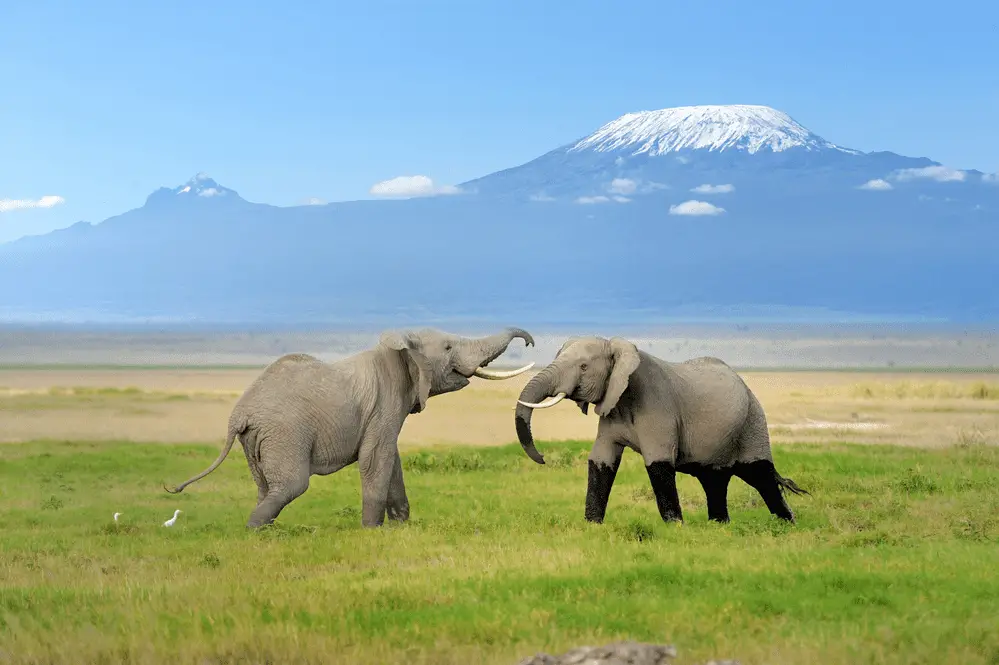Table of Contents
*This post may contain affiliate links. As an Amazon Associate we earn from qualifying purchases.
Mount Kilimanjaro stands majestically over the African plain, steeped in legend and beauty. Visitors from across the globe visit Africa to behold this natural wonder and even embark on a journey to climb it. But how much do you really know about this world treasure? We’ll reveal interesting facts and figures about this incredible mountain.
What Is Mount Kilimanjaro?
Mount Kilimanjaro is the highest point in Africa. Located in Tanzania, it has beckoned climbers and adventurers throughout the years. The summit of the mountain is covered by a large glacier, creating a striking, memorable pose over the flat land of the Serengeti.
While it’s not clear how the mountain came to be named Kilimanjaro, many think that the name is a combination of the Swahili word “kilima,” which means mountain and a Chagga word “njaro,” which means whiteness. Some claim that it is the European pronunciation of a sentence in the Chagga language that means “we failed to climb it.”
At one point in history, there were three volcanic cones on Kilimajaro. These cones were named Kibo, Shira and Mawenzi. The summit lies on Kibo, the tallest one. Kibo is actually a dormant volcano, meaning that it could still erupt. (The last time it erupted was 360,000 years ago.) When the Shira cone collapsed, it created the Shira plateau. Mawenzi, at 16,896 feet, is the third highest peak in Africa.
The Ecology of Kilimanjaro
Perhaps one of the most fascinating facts about Mount Kilimanjaro is that those who climb it experience five different ecological zones on their trek. As they climb higher, the zones grow colder and drier. Those who trek up the side of Kilimanjaro will eventually see plant and animal life disappear as they approach the snow and ice of the summit.
The summit is considered an arctic zone, an extreme temperature zone with land covered by ice and rock. While short exposures to this type of environment are tolerable, the environment is too extreme for human beings to live–or even to spend large amounts of time in. Mount Kilimanjaro is known for its striking glaciers which cover the summit. These glaciers are threatened by deforestation, but recently many trees have been plantedin an effort to recalibrate the summit.
How Do You Get to Kilimanjaro?
If you would like to visit the mountain, the easiest way is to fly into Mount Kilimanjaro’s own airport. Seven airlines fly to JRO, and this is often the easiest, quickest, and simplest route. From the airport, you will need to go to a hotel in one of the surrounding towns of Moshi or Arusha. Typically, if you are arriving as part of a climbing tour or trek this will be included in your trip.
Things to Know About Mount Kilimanjaro
Here are some fascinating facts about Mount Kilimanjaro:
Height
It’s the tallest mountain in Africa. This means it’s also one of the “seven summits.” The seven summits are comprised of the tallest mountain on each continent.
Climbing
Climbing to the top of Kilimanjaro does not require any extensive mountaineering skills; the trek is like a long, steady, upward hike.
Relative Size
Kilimanjaro is the tallest free-standing mountain in the world. Its point is 5,895 meters–or 19,341 feet– above sea level. This means it is not a part of an extensive mountain range. The summit is named Uhuru Point.
Ecology and Wildlife
Although it is only 205 miles from the equator, the top is covered with glaciers. There is a lot of wildlife on Mount Kilimanjaro, though many prefer to stay away from the mountain’s heavily traveled trekking routes. Some of the animals that call the mountain home include monkeys, leopards, buffalo and elands.
Do People Climb Mount Kilimanjaro?
Perhaps because it does not require extensive mountaineering training, Mount Kilimanjaro is a popular climbing spot. An estimated 30,000 people climb Kilimanjaro annually. Roughly half of those attempting the climb fail, mainly because of altitude sickness.
What Is the Best Route to the Top of Mount Kilimanjaro?
Most who fail to make it to the top are trying to get to the summit via the Marangu Route. This is the shortest path and takes about five days round trip. Many recognize that the best path to the top of Mount Kilimanjaro actually takes a bit longer. Why would you want to take the longer route when going up a mountain? Because this gives your body time to acclimatize to the new environment. This is an essential part of avoiding altitude sickness. The longer routes take roughly nine days to complete.
Who Was the First to Climb Kilimanjaro?
The first successful summit of Kilimajaro was in 1889 by a team that was comprised of Hans Meyer, a German geologist; Ludwig Purscheller, an Austrian climber; and local guide, Yohani Kinyala Lauwo.
The 1889 attempt was not Meyer’s first attempt. That was in 1887, where he had to turn back at the foot of Kibo because he did not have the equipment that he needed to work with the snow and ice. He tried again in 1888 and was not successful.
Mount Kilimanjaro Climbing Records
The oldest person to climb Mount Kilimanjaro is Anne Lorimor, an American woman who was 89 years old when she reached the top in 2019.
While 10 years of age is the minimum for climbing Mount Kilimanjaro, the government does sometimes present exceptions to children with lots of trekking experience. The youngest person to climb Mount Kilimanjaro was Coaltan Tanner, a six-year-old American who climbed to the peak in 2018. The youngest girl to reach the top of Mount Kilimanjaro was Montannah Kenney, who was seven years old when she reached the summit.
The person who ascended and descended Mount Kilimanjaro the fastest was Karl Egloff, from Switzerland. In 2014, he made the round trip in just 6 hours and 42 minutes. It’s important to make note that athletes who typically do faster climbs of mountains have generally already acclimatized to the environment before they make an attempt to trek to the summit.
The South African Bernard Goosen scaled Mount Kilimanjaro twice in a wheelchair. Goosen was born with cerebral palsy and needed to use a modified wheelchair. He made it to the summit mostly without assistance. In 2003, he made his first summit in nine days. In 2007, his trip took six.
What to Know Before You Go
Height and Climb
While it doesn’t take any specialized mountaineering training to climb Mount Kilimanjaro, that doesn’t mean that the climb will be “easy.” There are still steep inclines, boulders that are two-feet high, and long trails. All tourists and those wishing to climb must register with the park system and go with a licensed guide. Remember that camps on the mountain aren’t stocked with any amenities, so bring your own toilet paper and other “luxury” items.
Temps
When you decide to climb Mount Kilimanjaro, realize that you’ll be trekking in an area that is filled with extremes. The day time temperatures may hover in the 80s only to drop to freezing at night. Be prepared to mentally and physically handle these extremes.
Advice for Trekking
Trekking slow and steady will help you win the race. There’s a reason you shouldn’t push yourself when going up the mountain. For starters, there’s altitude sickness. Giving your body plenty of time to acclimatize will help you avoid it. Don’t try to keep up with the fastest trekkers in the group. Take time to enjoy the beauty and wonder of the mountain.
It’s important to be in good shape when you attempt to climb Mount Kilimanjaro, but realize this is only part of the struggle. Altitude sickness is one of the main obstacles that stand between trekkers and the summit. Symptoms include vomiting, nausea and even sometimes hallucinations.
What to Bring
First, it’s important that you ask your agency what items are provided. Some may provide sleeping mats and others may have equipment that is available for rent. It is absolutely vital that you understand what you are expected to bring and what your outfitter will provide.
In many cases, it may be more economical to rent items instead of buying them. An advantage of renting them is that they are more suited to the specific requirements for the Mount Kilimanjaro environment. However, some items you should definitely bring from home are thermal underwear, fleeces and boots.
The key to staying warm on Kilimanjaro is in layering. This layering can act as an effective insulation, and you’ll be able to “peel down” when the weather is hot and then add layers as it cools when the temperatures drop.
Clothes You Should Pack for Kilimanjaro
- A good pair of trekking boots that are durable, sturdy, waterproof and provide ample ankle support
- Both thick thermal and regular socks
- Fleeces that are lightweight and warm
- Down jackets that are large enough to fit over all your clothes
- Thermal underwear, thermal vest and long johns
- Pants specifically designed for trekking (do not take jeans because they are too heavy and will be very difficult to dry out)
- Sun hat or baseball cap as well as wool and fleece caps for when the temperatures drop
- Something to keep your neck from being exposed to the sun
- Both thin and thermal gloves; fleecy gloves will particularly be helpful when the temperature drops to freezing.
- Rainwear or waterproof jacket.
This is not a complete list. Be sure to check with your guiding company for a full list of items to bring with you. Know what you’re responsible for bringing, what will be provided, and what you can rent. Amd above all, be sure to carry a variety of items so you are prepared for any type of weather. Things can change quickly on Kilimanjaro!
Some Useful Tips on Climbing Mount Kilimanjaro
While getting to the top is more of a trek than a climb, do not think that getting to the summit is “easy.” That being said, climbing Kilimanjaro does not require the intense skill as climbing other mountains of the Seven Summits (such as Denali or Everest).
Realize that it is altitude sickness that causes most climbers to have to return down to camp. Therefore, take your time and get your body acclimated to the environment.
It’s often best to go with a good company who can handle the portage for you and provide some of the equipment needed. There are a wide range of prices and a great variance in the quality of the companies and what is provided. Be sure to do your research before you consider going.
Finally, remember that eou’ll enjoy your time on the mountain more if you stick to a fitness regime before you go. The better shape you’re in before you arrive, the more you’ll be able to think about the beauty of your trip rather than how you feel!
Conclusion
People from all over the world climb Mount Kilimanjaro. While the trek is challenging, it does not require any extensive mountaineering skills. Therefore, it can be easily attempted by those with no mountaineering experience. If you decide to climb Mount Kilimanjaro, it’s important to make an extensive list of the items you’ll need to take with you and go with a reputable trekking company.

